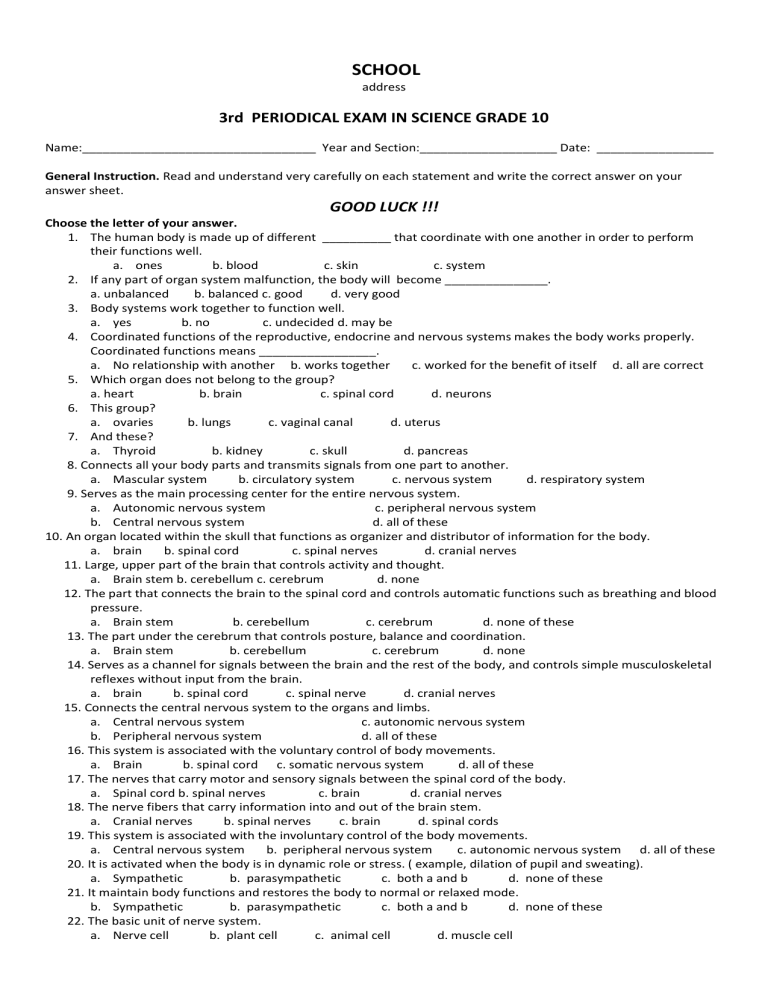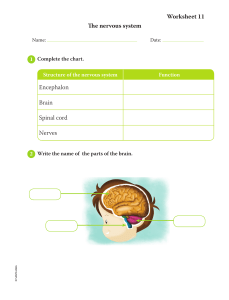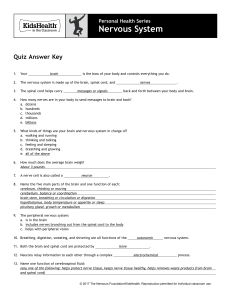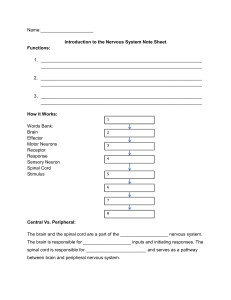
SCHOOL address 3rd PERIODICAL EXAM IN SCIENCE GRADE 10 Name:__________________________________ Year and Section:____________________ Date: _________________ General Instruction. Read and understand very carefully on each statement and write the correct answer on your answer sheet. GOOD LUCK !!! Choose the letter of your answer. 1. The human body is made up of different __________ that coordinate with one another in order to perform their functions well. a. ones b. blood c. skin c. system 2. If any part of organ system malfunction, the body will become _______________. a. unbalanced b. balanced c. good d. very good 3. Body systems work together to function well. a. yes b. no c. undecided d. may be 4. Coordinated functions of the reproductive, endocrine and nervous systems makes the body works properly. Coordinated functions means _________________. a. No relationship with another b. works together c. worked for the benefit of itself d. all are correct 5. Which organ does not belong to the group? a. heart b. brain c. spinal cord d. neurons 6. This group? a. ovaries b. lungs c. vaginal canal d. uterus 7. And these? a. Thyroid b. kidney c. skull d. pancreas 8. Connects all your body parts and transmits signals from one part to another. a. Mascular system b. circulatory system c. nervous system d. respiratory system 9. Serves as the main processing center for the entire nervous system. a. Autonomic nervous system c. peripheral nervous system b. Central nervous system d. all of these 10. An organ located within the skull that functions as organizer and distributor of information for the body. a. brain b. spinal cord c. spinal nerves d. cranial nerves 11. Large, upper part of the brain that controls activity and thought. a. Brain stem b. cerebellum c. cerebrum d. none 12. The part that connects the brain to the spinal cord and controls automatic functions such as breathing and blood pressure. a. Brain stem b. cerebellum c. cerebrum d. none of these 13. The part under the cerebrum that controls posture, balance and coordination. a. Brain stem b. cerebellum c. cerebrum d. none 14. Serves as a channel for signals between the brain and the rest of the body, and controls simple musculoskeletal reflexes without input from the brain. a. brain b. spinal cord c. spinal nerve d. cranial nerves 15. Connects the central nervous system to the organs and limbs. a. Central nervous system c. autonomic nervous system b. Peripheral nervous system d. all of these 16. This system is associated with the voluntary control of body movements. a. Brain b. spinal cord c. somatic nervous system d. all of these 17. The nerves that carry motor and sensory signals between the spinal cord of the body. a. Spinal cord b. spinal nerves c. brain d. cranial nerves 18. The nerve fibers that carry information into and out of the brain stem. a. Cranial nerves b. spinal nerves c. brain d. spinal cords 19. This system is associated with the involuntary control of the body movements. a. Central nervous system b. peripheral nervous system c. autonomic nervous system d. all of these 20. It is activated when the body is in dynamic role or stress. ( example, dilation of pupil and sweating). a. Sympathetic b. parasympathetic c. both a and b d. none of these 21. It maintain body functions and restores the body to normal or relaxed mode. b. Sympathetic b. parasympathetic c. both a and b d. none of these 22. The basic unit of nerve system. a. Nerve cell b. plant cell c. animal cell d. muscle cell 23. Nerve cells are also called __________________? a. Dendrites b. axon c. neurons d. none of these 24. Number of neurons in one part of the brain. a. 3 to 5 billions b. 6 to 8 billions c. 9 to 11 billions d. 12 to 14 billions 25. Which of the following parts of nervous that carry impulses toward the cell body. a. Axon b. cell body c. dendrites d. nucleus 26. Carry impulses away from the cell body. a. Axon b. cell body c. dendrites d. nucleus 27. A typical measurement of single dendrites. a. 1 meter b. 2 meters c. 3 meters d. 4 meters 28. The grouped of axons is called _______________? a. Muscles b. organs c. Tissues d. nerves 29. An organs constantly receiving information from the environment and sending messages to the brain. a. Nerve organs b. muscle cells c. sex organs d. sense organs 30. Any factor in the environment that may trigger a nerve impulse. a. response b. messages c. senses d. stimulus 31. Received by the body and a response is made. a. senses b. stimulus c. messages d. response 32. A reaction to a stimulus is called __________________. a. stimulus b. messages c. senses d. response 33. An organism must be able to respond to a stimulus in order to _______________. a. survive b. live c. both a and b d. none of these 34. Messages do not travel in both directions along the same neurons. a. yes b. no c. undecided d. may be 35. Endocrine system controls and regulates body processes. a. yes b. no c. undecided d. may be 36. Rapid body processes such as body movement and breathing are controlled by _____________. a. endocrine system b. circulatory system c. respiratory system d. nervous system 37. Stimulates growth and controls the functions of other glands. a. parathyroid b. thymus c. adrenal d. pituitary 38. Regulates body metabolism and causes storage on calcium in bones. a. thymus b. adrenal c. thyroid d. pituitary 39. Control maturation and male characteristics. a. ovaries b. pancreas c. parathyroid d. testes 40. Regulates blood sugar levels. a. ovaries b. testes c. pancreas d. pituitary 41. Affects various processes in the body as they regulate and balance the functioning of organs, tissues and cells. a. system b. muscles c. nerves d. hormones 42. An increase or decrease in hormonal levels may result in body disorder due to ___________. a. Hormonal balance b. hormonal imbalance c. body hormones d. no hormones 43. The system involved in sexual reproduction is called _____________. a. mascular system b. skeletal system c. reproduction system d. respiratory system 44. Produces egg cells. a. testes b. ovary c. uterus d. penis 45. Serves as passageway of eggs from the ovary to the uterus, site of egg fertilization. a. oviduct b. ovary c. uterus d. testis 46. Produces sperm cells. a. testis b. ovary c. uterus d. penis 47. Carries sperm from testes to urethra. a. oviduct b. vas deferens c. ovary d. seminal vesicle 48. Involves the onset of sexual maturity and the ability to reproduce. a. old age b. marriage c. puberty d. childhood 49. Sac of skin that holds the testis. a. ovary b. prostate glands c. urethra d. scrotum 50. Serves as site of egg implantation, is where the fertilized egg develops. a. urethra b. scrotum c. oviduct d. uterus Prepared by: Name Subject Teacher Noted: Parent’s Signature name School Head/HT1 Name:_______________________ (Mother/Father)






